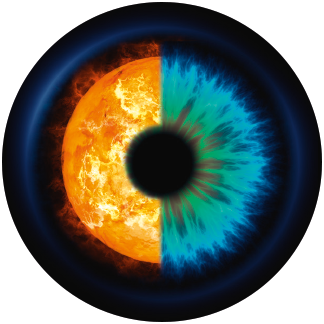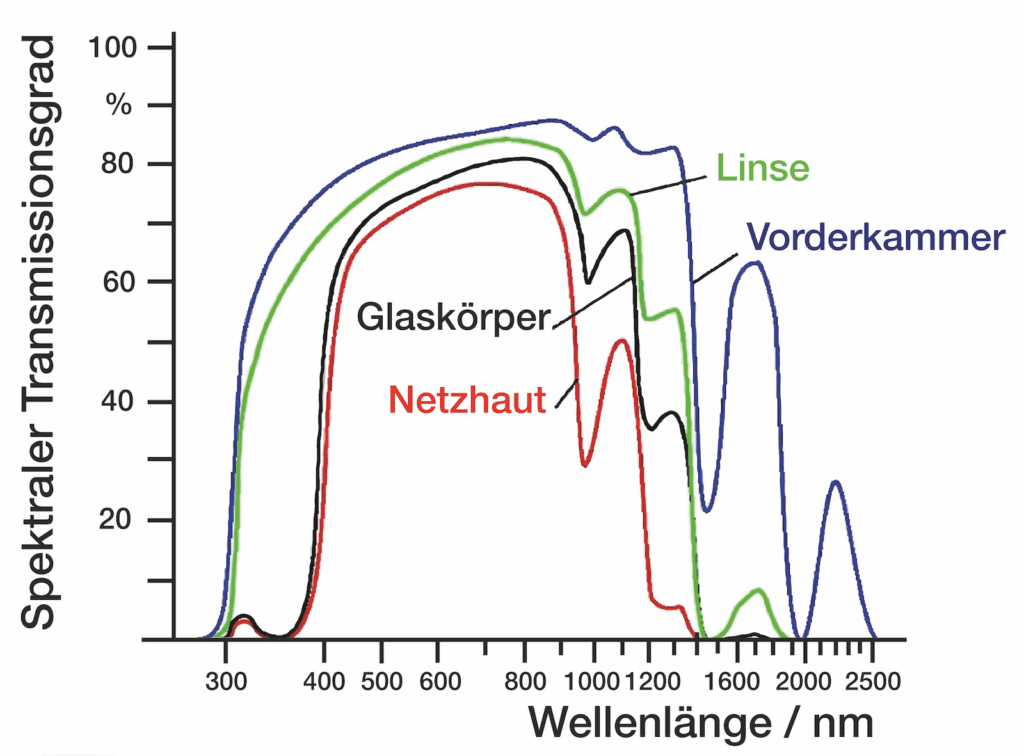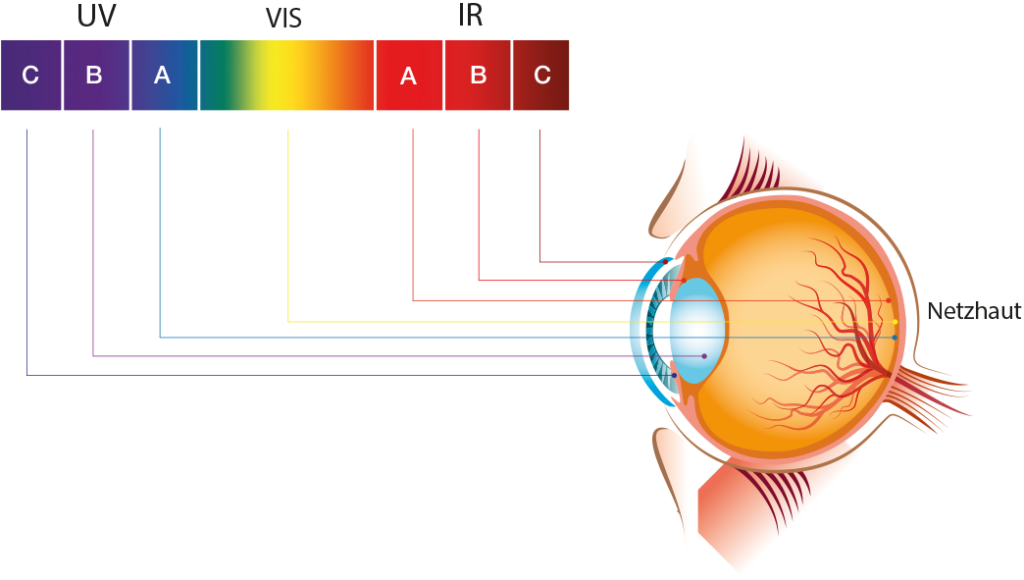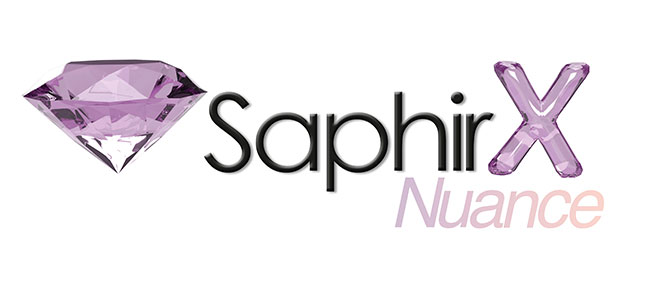UV AND infrared protection
for your eyes

Protect your eyes not only from UV radiation, but also against infrared radiation (IR). In addition to UV light, our Saphir X IR lens coating also blocks the sun’s harmful infrared rays, providing optimum protection for your eyes in strong sunlight.

Infrared & UV protection for the eyes
Why is additional infrared protection for the eyes so important alongside UV protection? The simple answer to this question is that we are getting older on average. Our eyes are simply ‘wearing parts’. As certain components of the eye, such as the retina, cannot be repaired in the long term, it is important to minimise wear and tear as much as possible. And this is where infrared protection comes into play.

While the average life expectancy of a woman born in Germany in 1950 was 68.5 years, it has already reached 83.4 years for a woman born in 2015. (Source: Federal Statistics Office 2018). Given this trend, we can assume that life expectancy will continue to increase and that we – and our eyes – will get older and older.
If you want to maintain your eye health into old age or optimally protect your eyes after cataract surgery, you should pay attention to infrared protection in your lenses.
Our Saphir X IR coating prevents long-wave infrared rays from reaching the inside of the eye, where they could otherwise cause lasting damage. The coating can be used for the lenses of your everyday lenses as well as your sunglasses.
Ultraviolet Radiation (UV)

- Not visible to our eyes
Visible Light (VIS)

- Only this area is visible to the human eye
Infrared Radiation (IR)

- Not visible to our eyes
You are currently viewing a placeholder content from YouTube. To access the actual content, click the button below. Please note that doing so will share data with third-party providers.
More InformationWhy is Infrared Radiation Dangerous?
The atmosphere already filters much more UV light than infrared radiation from the light spectrum.
Conventional sunglasses do not absorb the infrared range. Therefore, in contrast to UV light, the infrared radiation reaches the eye unfiltered – with the pupil significantly wider (because the darkening sunglasses cause the pupils to dilate again).
According to findings of the Association for Radiation Protection, infrared rays with a wavelength between 780 and 10,000nm can seriously damage the eye. In contrast to UV rays, the energy of the IR rays is not sufficient to cause photochemical reactions, but the rays lead to significant warming of the inside of the eye.
The energy of infrared radiation absorbed by the eye results in warming, which leads to turbidity of the lens of the eye (cataract) with long-term exposure to IR radiation.
Would You Like to Know More?
According to findings of the Association for Radiation Protection, infrared rays with a wavelength between 780 and 10,000nm can seriously damage the eye. In contrast to UV rays, the energy of the IR rays is not sufficient to cause photochemical reactions, but the rays lead to significant warming of the inside of the eye.
The key question to assess the damage caused is: What actually reaches which part of the eye?
The predominant IR-A component of sunlight penetrates in the range of up to 1,400nm with a significant proportion even reaching the retina. This simply a result of the general rule: The shorter the wavelength of the IR radiation, the deeper it penetrates. This particularly affects the chorioidea (choroid) which can become damaged by IR-A. This can lead to local tissue defects in the retina. Only a small amount of radiation with a wavelength greater than 2000nm is able to penetrate the cornea. The anterior chamber absorbs all radiation over 2000nm. All wavelengths larger than 1400nm are filtered out through the lens and vitreous humour.

Radiation within the wavelength range of 400nm to 1400nm the is therefore able to reach retina. The energy of infrared radiation absorbed by the eye results in warming (Vos and Norren 2004, Brose et al., 2005). The exact mechanism of action which leads to turbidity of the lens (cataracts) during long-term exposure to IR radiation, is still uncertain (Brose et al., 2005). It is also difficult to distinguish between fundamentally multifactorial, age-related cataract development with a variety of biochemical changes – in particular changes in the composition of lens proteins with increasing aggregations of water-insoluble high molecular weight proteins – and cellular changes that are genetically modified and enhanced and exacerbated by environmental factors (Truscott and Zhu , Michael and Bron, 20122). *This is, however, precisely why certain cataract diseases are called “fire gaze” or “glass-blower’s eye”, meaning that the influence of infrared radiation on such formations, although these develop very gradually and are difficult to test, is considered difficult to prove, but considered highly likely.
*Guideline of the German Society of Occupational Medicine and Environmental Medicine. Work with exposure to infrared radiation (heat radiation)
– Dangers and damage to eyes and skin (AWMF Register No. 002/010 Class: S1 02/2012).

Infrared radiation (IR-A, IR-B, IR-C) penetrates particularly deep into the eye - right up to the retina. There it can damage the tissue.

Invisible Danger: Radiation Penetrates Deep into The Eye
Depending on the wavelength, light penetrates different layers of the eye. Effective protection should therefore cover more than just UV – infrared radiation (especially IR-A) must also be filtered in order to fully protect the eye. You should therefore pay particular attention to infrared protection in sunglasses.
Choose Infrared Protection Lenses With Saphir X IR Technology for Your New Sunglasses.
Our Saphir X IR infrared protection coating can be combined with almost all colourless lenses and sun protection lenses with 85% tint. This means you can optimally protect your eyes with both your normal lenses and your sunglasses.
- Infrared Blocker Layer
- Super Hard Layer
- Super Anti Glare
- Anti Static Layer
- Super Hydrophobic Layer


Composition of sunlight
In Dermatology, Infrared Protection Has Long Been a Hot Topic
In the field of dermatology in particular, research is already ongoing and there are relevant studies on the damage caused by infrared radiation, which have already been incorporated in the development of new sunscreen creams. The view taken by manufacturers of these sun protection products is: “without infrared protection you are only half protected from solar radiation” as infrared radiation represents more than 40% of the sunlight spectrum.
The sun doesn’t just tan us, it also warms us. Not only our skin, but also our eyes. So we should also protect our eyes from infrared rays.
The Development of Sunglasses
After initial suspicions in the mid-19th century that UV light could be harmful, Crookes sunscreens were released as early as 1913, providing a guarantee of 100% UV light protection. In 1908, the Swiss ophthalmologist Alfred Vogt managed to prove the health effects of UV radiation. In 1926, he published his combined findings demonstrating that ultraviolet light has a harmful effect on the eye. It it also worth noting that he had already pointed out that infrared radiation was suspected to have a similarly damaging effect.
In 1930, the first sunglasses began to be produced, with the primary focus still on preventing glare caused by sunlight. In addition to their use as a fashion accessory, protection standards for sun- Development of sunscreen products lenses were introduced, such as the last standard EN1836, which ensures complete UV protection, where 95% absorption occurs in a range up to 380nm. The more popular standard and one known to every wearer of sunglasses, is now the UV400 seal, which is even effective in visible light and also blocks harmful high-frequency blue light.
We wonder: What ever happened to infrared protection? This has been neglected in recent decades, yet infrared light is extremely harmful to the eyes. For this reason, we have invested a lot of time and innovation in the development of our Saphir X IR technology.

The lenses are visually very appealing, since the Saphir X
IR acts like a subtle flash mirror-coating.

Lenses With Infrared Protection After Cataract Surgery
People who have undergone eye surgery (cataract surgery) need extra protection due to the loss of the filtering properties of the natural lenses. UV and infrared protection in sunglasses is particularly recommended in such cases to prevent the retina from being exposed to additional stress.
Premium Coatings in The Overview

- UV-Protection
- Antistatic & Clean Layer
- Superhydrophobic Layer
- Super Hard Coating
- Super Anti-Reflection
- For quality-conscious people with a high aesthetic standard.

- UV-Protection & Infrared Protection
- Antistatic & Clean Layer
- Superhydrophobic Layer
- Super Hard Coating
- Super Anti-Reflection
- For wearers who spend a lot of time in the sun and/or individuals with sensitive eyes, such as after a cataract operation (recommended for sunglasses and prescription lenses).

- UV-Protection
- Antistatic & Clean Layer
- Superhydrophobic Layer
- Super Hard Coating
- Super Anti-Reflection
- For the quality-conscious eyeglass wearer who places great value on durability and longevity.
Opticians can find more information about our premium finishes in our product catalogue – to the catalogue.
Do you have any questions about infrared protection or any other concerns?

About Wetzlich
We have been manufacturing lenses with the highest precision and innovative strength in Germany since 1935.
We not only ensure that you simply see better and more with our products. For years we have been developing lenses that provide optimum protection for your eyes. This includes e. g. our UV and infrared protection coating as well as innovative lens materials that filter blue light and increase contrasts.
With one of the most modern European machine setups, we stand for advanced products with the highest quality standards at fair prices.
You can purchase WETZLICH lenses from your local optician. Simply ask him about our lenses or find a WETZLICH partner optician in our optician search.

